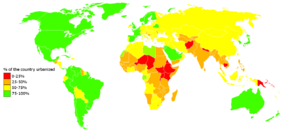

Urbanization is the transformation of a rural area into a city area. It thus refers to placing infrastructure (buildings, roads) in an area, hereby improving trade and increasing the livelihood of people. This improvement occurs, partially because of easier transport (better road system) and partially because of a higher population density. Higher population density reduces travel distance, allowing more walking and cycling, and provides a larger customer base for public transport.
Overview[edit | edit source]
At present, 3% of the Earth's land surface is occupied by urban areas. Urbanization has increased hugely over the last centuries (from 3% of the the global population living in urbanized areas in the 1800's to 50% of the population living there today[1] This has had a very beneficial effect to the environment, allowing the earth to cope (to some degree) with the rising population (which currently sits at 7 billion people whereas it actually needs to be at about 2 billion people)[2]
Population density[edit | edit source]
The article Green Manhattan[3] makes a case for very large buildings and densely populated cities, such as Manhattan, being a far more sustainable form of settlement than low-density suburbia.
Affordability[edit | edit source]
In theory, higher housing density can be cheaper, and allow for cheaper provision of services and public transport. Higher density housing in the form of apartments and terrace housing also has the potential to have lower heating and cooling requirements (an advantage for both sustainability and housing affordability). Local regulations often work against this however, for example density caps, height limits and requirements for housing setback. Some of these do have good reasons, but could arguably be solved in other ways with less restriction on density, thus less restriction on housing supply, and potentially/theoretically lower housing costs.
A paradox is that large cities where high densities are found are generally less affordable - this is hard to analyze, as a large city with low density is also generally very expensive. However by having high densities they occupy less space for the same population, and make it more achievable to have affordable housing within close reach of the center by public transport or cycling.
Transport[edit | edit source]
In a compact city, travel distances are shorter, making journeys by walking, bike and public transport more appealing, with benefits for public health (physical and mental) sustainability, while reducing costs for commuters.
Benefits of building size[edit | edit source]
The environmental economies of scale mean that large buildings and large cities can be much more efficient[3] Unfortunately this is not always the case - some apartments have a higher energy usage than houses, due to poor design and reliance on clothes driers rather than clotheslines for drying clothes.[verification needed]
Living environment[edit | edit source]
There are complexities of course - higher density housing does not make open green space a bad thing. However, higher densities in buildings mean more space left over for parks, etc. We can have more usable public space, yet still have higher density overall.
Reducing the environmental impact even more[edit | edit source]
Maps of the currently urbanised areas on the world can be found at
- http://web.archive.org/web/20140928163200/http://esa.un.org:80/unup/Maps/maps_urban_2011.htm
- http://www.earth.columbia.edu/news/2005/story03-07-05.html
- http://commons.wikimedia.org/wiki/File:Agglo19502050.png?uselang=en (exagerrated map)
It is clear that, in order to decrease our environmental impact even more, the urban sprawl should be discontinued and in addition, we can also eliminate limit the expansion of infrastructure/roads at the outskirts of cities/urbanized zones and remove infrastructure/roads that lie compompletely in non-urbanized zones (ie where no cities are found at all).
In addition, wildlife corridors can be made within urbanized areas.
See also[edit | edit source]
- Dense-low
- New Urbanism
- Using internet access to persuade people to move to the city
- Transit-oriented development
References[edit | edit source]
- ↑ http://www.english-online.at/geography/world-population/urban-areas.htm
- ↑ WWF's Living Planet report stating that if we all want to live with a high degree of luxury (European standards), we would be spending 3x more than what the planet can supply, and current population number is 7 billion people.
- ↑ 3.0 3.1 Green Manhattan - Why New York is the greenest city in the U.S. By David Owen, The New Yorker, 18 Oct 2004.